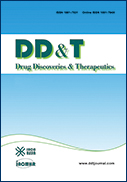Volume 13, Issue 4
Displaying 1-10 of 10 articles from this issue
- |<
- <
- 1
- >
- >|
Review
-
Article type: review-article
2019 Volume 13 Issue 4 Pages 177-182
Published: August 31, 2019
Released on J-STAGE: September 18, 2019
Download PDF (415K)
Original Articles
-
Article type: research-article
2019 Volume 13 Issue 4 Pages 183-188
Published: August 31, 2019
Released on J-STAGE: September 18, 2019
Download PDF (244K) -
Article type: research-article
2019 Volume 13 Issue 4 Pages 189-197
Published: August 31, 2019
Released on J-STAGE: September 18, 2019
Download PDF (1117K) -
2019 Volume 13 Issue 4 Pages 198-206
Published: August 31, 2019
Released on J-STAGE: September 18, 2019
Download PDF (883K) -
Article type: research-article
2019 Volume 13 Issue 4 Pages 207-211
Published: August 31, 2019
Released on J-STAGE: September 18, 2019
Download PDF (353K) -
2019 Volume 13 Issue 4 Pages 212-221
Published: August 31, 2019
Released on J-STAGE: September 18, 2019
Download PDF (1700K)
Brief Report
-
Article type: research-article
2019 Volume 13 Issue 4 Pages 222-227
Published: August 31, 2019
Released on J-STAGE: September 18, 2019
Download PDF (487K)
Case Report
-
Article type: case-report
2019 Volume 13 Issue 4 Pages 228-231
Published: August 31, 2019
Released on J-STAGE: September 18, 2019
Download PDF (2301K) -
Article type: case-report
2019 Volume 13 Issue 4 Pages 232-238
Published: August 31, 2019
Released on J-STAGE: September 18, 2019
Download PDF (2335K) -
Article type: case-report
2019 Volume 13 Issue 4 Pages 239-243
Published: August 31, 2019
Released on J-STAGE: September 18, 2019
Download PDF (1797K)
- |<
- <
- 1
- >
- >|
